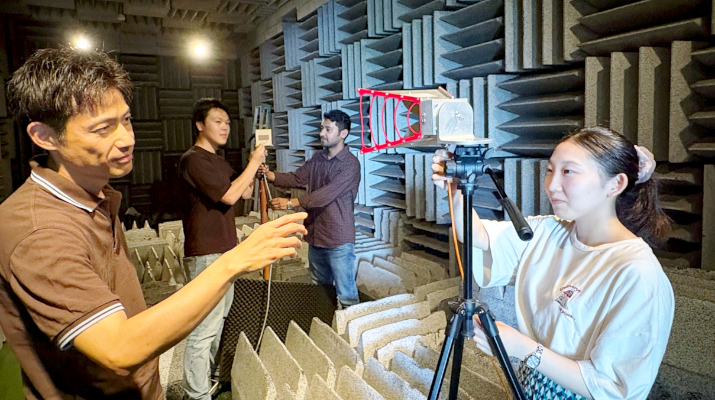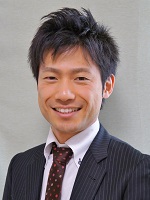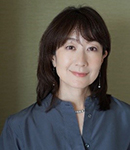
ここからコンテンツです。

Using antennas as resonators to design circuits with fewer elements
Masaya Tamura
With the exponentially increasing volume of information due to the growing demand for IoT devices, the effective utilisation of the frequency bands used for wireless communication has become a challenge.Against this backdrop, Professor Masaya Tamura has developed a radio frequency (RF) circuit that uses antennas as resonators. Professor Tamura has successfully used the innovative approach of treating antennas as resonators to significantly reduce the number of components while preventing radio interference. The inspiration for this innovation came from the concept of an “equivalent circuit”.
Interview and report by Madoka Tainaka
Aiming to eliminate interference between antennas
Various wireless communication methods, such as smartphones, Wi-Fi, and Bluetooth, are currently used depending on the application. The frequency bands that can be used for each method are regulated by the Radio Act. However, the rapid increase in the volume of information has highlighted the critical challenge of effectively and efficiently using each frequency band. In response to this challenge, Professor Tamura and his team have been studying a method known as “in-band duplex communication”.
“For instance, we can all picture how, if inbound and outbound lanes are not separated on a highway, then cars will collide with each other and cause accidents.However, our method enables the simultaneous use of the same frequency for transmission and reception.
That said, challenges remain. Using the same frequency means that transmitting and receiving antennas placed close to each other will pick up each other’s radio waves, causing interference. Eliminating this inter-antenna coupling is the goal of my research. This method can be used not only for in-band duplex communication, also for multiple-input multiple-output (MIMO), a technology which uses multiple antennas to increase the speed, reliability, and flexibility of wireless communication. Even in MIMO systems, interference between the antennas can lead to significant reductions in communication speed and quality”, explains Professor Tamura.
In practice, what specific ideas did the research team explore? Conventional methods for avoiding interference involve physically separating antennas, tilting them 90 degrees to form a cross, or using other spatial arrangements to prevent interference.
“Regrettably all these methods would inevitably take up too much space. Accordingly, we started researching how to create a circuit that would prevent radio interference even with a small distance between the antenna by applying filter theory. In this case, two resonant circuits function as filters. They generate two attenuation poles near the operating frequency of the antennas, achieving wideband attenuation and suppressing interference”.
However, this method introduced complications, including an increased number of chip components, not only for the antennas, but also for the resonant and transmitting circuits, as well as those ensuring their consistency. Moreover, manufacturing variations across chips made assembly more time-consuming as efforts to fine-tune performance increased.
“What I realized at this point was that the antennas were functioning as resonators”, Professor Tamura recalls.
Finding inspiration from the words of senior colleagues
“What antennas do is to receive and transmit radio waves within the desired frequency band by creating a resonance phenomenon. From this arose the idea of using the antenna itself as a resonator”.
Professor Tamura stated that the seeds of this insight originated from advice given to him by two key figures. One of these was Yohei Ishikawa, at that time Director of the Murata Manufacturing R&D Center, with whom Professor Tamura had become acquainted over the course of academic conferences and other events while working at Panasonic. The other was the late Professor Tatsuo Itoh of UCLA, who served as a mentor in joint research projects.
“Both of them firmly believed that the key to understanding radio and electromagnetic wave phenomena is to first grasp the physical phenomenon by expressing them as an equivalent circuit , and only then to proceed with creation. In other words, all physical phenomena can be described using R (resistor), L (inductor), and C (capacitor). Following this advice, I drew the equivalent circuit and noticed that antennas resemble resonators. That’s when it hit me, that I could reduce the number of elements!”
Nevertheless, it took extensive trial and error to develop the method. The patch antenna was designed to target the 2.4–2.5 GHz band, commonly used by wireless LANs such as Wi-Fi. When spacing the two antennas close together down to 0.2 mm, considering integration into smartphones and small sensors, simulations showed that approximately half the power from one antenna was absorbed by the adjacent one, preventing long-distance transmission.
“Solving this problem required increasing the resonance distance between the two antennas while monitoring the admittance (ease of power flow) between them. This may get a bit technical, but we analyzed the characteristics of the two antennas using a method called even-odd mode. We devised new ways to connect transmission lines and add capacitors such that the admittance would be zero, effectively cutting the line”, explains Professor Tamura.
This enabled the transmittance of nearly all the power sent to the antenna as radio waves into space without loss. The research team also successfully reduced the number of elements from 14 in earlier designs to 6. This design theory served as the foundation for creating and measuring an actual circuit, yielding results consistent with simulations using a very simple configuration. The reduced number of elements also minimized the impact of component variation, allowing the research team to develop a circuit completely free of inter-antenna interference.
“The electromagnetic waves that can be transmitted and received are currently limited to a narrow range of approximately 2.45 GHz. Thus, we are currently conducting joint research with companies to expand this bandwidth”, explains Professor Tamura. Their research is accelerating toward practical application.
Wide-ranging research: from smart factories to power supply to underwater drones
Professor Tamura’s laboratory has also been working with Aichi Prefecture and local companies on basic research into smart factories, which aim to eliminate all wiring in factories and handle all aspects from information transmission to power supply.
“Smart factories aim to monitor robot operations and production processes using sensors to improve work efficiency and reduce product defects . However, wiring failures and the need for sensor battery replacement have been identified as challenges. Therefore, we are researching how to use metal meshes (safety fences) surrounding production equipment as pseudo-shielded spaces to confine radio waves and wirelessly power the equipment. In this setup, radio waves at communication frequencies can be transmitted and received by them outside the wire mesh. This enables power supply and information communication without requiring human entry into the smart factory”, says Professor Tamura.
His laboratory is also researching charging and data transmission for underwater drones, which are used for deterioration diagnosis of bridges and dams, environmental monitoring in aquaculture, and marine resource exploration.
“Charging is a challenge here as well. In particular, marine resource exploration requires 7–8 hours just for diving and surfacing, leaving only approximately 3–4 hours for actual exploration. Therefore, we have been exploring options for placing a charging station underwater, initiating power supply when the drone lands on the bottom, and simultaneously transmitting exploration data to the station. If implemented, this would allow drones to be stationed underwater, enabling remote operation”.
The highlight of Professor Tamura’s research is the use of lightweight copper tape rather than coils as electrodes to avoid interfering with the drone’s buoyancy.
“With seawater, we had to be creative, as it is rich in ions, which can cause electricity to diffuse. Therefore, we used a cushion to absorb the impact of the drone hitting the sea floor, while trapping seawater to prevent electrical diffusion. This led to the development of a technology that uses high-frequency ion currents to transmit electricity with over 90% efficiency—the first of its kind worldwide. I think this is a much-needed technology that can really come into its own in places that are inaccessible to people," says Professor Tamura proudly. The research team is also working on wireless power supply to implantable medical devices such as pacemakers. This would eliminate the need for battery replacement through surgery, significantly reducing the burden on patients. Like all of Professor Tamura’s research, it is a step towards developing technology that responds to the real needs of society. We look forward to the swift practical implementation of these technologies.
Reporter's Note
Professor Tamura explains that, during his university years, he reflected on his desire to do work that helps people. One day in class, a professor told him, “Come to my lab if you want to know why we can talk on cell phones”. This intrigued him and led him to pursue research. He went on to complete his master’s degree and joined a company, an experience he says was highly valuable in his later career as a researcher. “Even then, I felt this significant gap between the research conducted at universities and the research and development at companies aiming for practical application. Thus, I have a clear vision of how my research will be used, and I conduct it with the goal of giving back to society.” This interview clearly showed why Professor Tamura is a sought-after partner for joint research with companies.
アンテナを共振器として利用し、素子の少ない回路を設計
田村 昌也IoTデバイスの需要の増加に伴い、指数関数的に情報量が増えるなか、ワイヤレス通信で利用される周波数帯域の有効活用が課題となっている。そうしたなかで、田村昌也教授が開発したのが、アンテナを共振器として利用したRF回路(Radio Frequency Circuit)だ。アンテナを共振器とみなすという目から鱗の方式で、電波干渉を防ぎつつ、素子数を大幅に減らすことに成功。そのひらめきのヒントは、ほかでもない「等価回路」にあった。
アンテナ間の干渉を除去したい
現在、スマートフォンやWi-fi、Bluetoothなど、用途に応じてさまざまなワイヤレス通信方式が活用されている。それぞれ利用できる周波数帯域が電波法により定められているが、情報量が急増する現在、いかに効率よくそれぞれの周波数帯域を有効活用できるかが重要な課題となっている。そこで、田村教授らが検討してきたのが、「帯域内二重通信」という方式だ。
「高速道路なら、上りと下りの車線が分かれていないと車がぶつかって事故を起こしてしまいますよね? ところが、この方式なら同じ周波数を送信・受信とも同時に使うことができるのです。
ところが問題もあって、同じ周波数を使うので、送信用と受信用、それぞれのアンテナが近くにあると、お互いの電波を拾い合って干渉してしまうんですね。このアンテナ間結合を除去するのが、私の研究になります。この方法を使えば、帯域内二重通信だけでなく、MIMO(Multiple-Input Multiple-Output)と呼ばれる、複数のアンテナを用いて無線通信の速度・信頼性・柔軟性を高める技術にも応用できます。この方式もアンテナ同士が干渉すると通信速度や品質が大きく低下してしまうんです」と田村教授は説明する。
では、具体的にどのような工夫をしたのか。従来は、アンテナ同士を離したり、90度傾けて十字になるように置いたり、干渉し合わないようにアンテナを物理的に考慮して配置するほかなかったが――。
「でもそれだと、どうしても場所を取ってしまいますよね。そこでアンテナ間の距離は近くても、フィルタ理論を応用することで、電波干渉を防ぐ回路をつくれないかと研究をしてきました。その際、フィルタの役割を果たすのが二つの共振回路です。これによりアンテナの動作周波数付近で二つの減衰極を形成し、広帯域な減衰を実現、干渉を防ぐことを確認しました」
しかしこの方式では、アンテナに加えて、共振回路、電波を送る送信回路と、それらの整合性を取るための回路と、チップ素子がどんどん増えていってしまうのが課題だった。しかも、それぞれのチップは製造のバラツキがあって、特性を出そうとすればするほど、回路の組み立てに手間がかかっていた。
「このとき気づいたのが、アンテナは共振器の役割を持っている、ということだったのです」と、田村教授は振り返る。
先輩たちの言葉が、ひらめきを生んだ
「そもそもアンテナというのは、共振現象を起こすことで所望の周波数帯域の電波を受信したり送信したりできます。そこで、アンテナを共振器として使えばいいとひらめいたのです」
このアイデアの糸口を与えてくれたのは、かつてパナソニックに勤めていた際に、学会などで親交のあった当時村田製作所次世代技術研究所 所長の石川容平さんと、共同研究などでご指導頂いたUCLAの故・伊藤龍男教授の言葉だったという。
「お二方とも、電波や電磁波の現象を理解するためには、まずは等価回路の形で表し、物理現象を理解しなければならない、そのうえでモノをつくることが大切だ、と、常々おっしゃっていました。つまりすべて、R(レジスター:抵抗)とL(インダクタ:コイル)、C(キャパシタ:コンデンサー)で、物理現象として何が起きているのかを書き表すことができる。その教えを守って、等価回路で書いてみたところ、アンテナってそもそも共振器と同じ形じゃないか、だったら、素子数を減らせるんじゃないか!と思いついたというわけです」
ただ、開発まで試行錯誤を重ねる必要があった。Wi-Fiなど無線LANの帯域である2.4〜2.5 GHzの帯域をターゲットにパッチアンテナを設計。その際、スマートフォンや小型センサなどへの搭載を念頭に二つのアンテナの間隔を0.2㎜まで近づけたところ、シミュレーション上、一つのアンテナから送った電力が隣のアンテナに5割くらい吸収されてしまい、遠くまで電波を飛ばせないことが判明したのだ。
「これを解消するためには、アンテナ間のアドミタンス(電力の流れやすさ)を確認しながら、二つの共振間隔を広げる必要がありました。そこで、ちょっと専門的になりますが、二つのアンテナの特性を偶奇モードという方法で解析して、アドミタンスがゼロになるように(回線が切れた状態になるように)、伝送線路を接続したり、コンデンサをつけたりする工夫を凝らしました」と田村教授。
これにより、アンテナに送られた電力のほとんどが失われることなく電波として空間に出せるようになった。さらに、先行研究では14個だった素子数を6個にまで減らすことに成功。この設計理論をもとに、実際に回路を作成して実測したところ、非常にシンプルな構成で解析通りの結果が得られた。素子数が減ったことで、素子のバラツキの影響も受けにくくなり、見事にアンテナ間の干渉のない回路を開発することができたのである。
「現状は、送受信できる電磁波が2.45GHz付近と狭い範囲に限られているため、この帯域を広げるために現在、企業との共同研究により改善方法を探っています」と田村教授。社会実装に向けて研究を加速しているところだ。
スマートファクトリーから水中ドローンへの電力供給など幅広く研究
田村教授の研究室では、そのほか、愛知県および愛知県内の企業と共同で、工場内の配線をすべて取り除いて、情報伝送から電力供給まで行うスマートファクトリーの基礎研究にも取り組んできた。
「スマートファクトリーとは、ロボットの稼働や生産工程をセンサでモニタリングして、効率よく作業を進め、製品の歩留を減らす試みですが、課題となってきたのが、配線の断線やセンサの電池交換です。そこで、生産設備を覆う金属網(安全防護柵)を擬似的な遮蔽空間として活用することで、内部に電波を閉じ込めて機器への給電を無線で行う研究をしています。その際、情報通信に使用する周波数の電波は金網の外に飛ばすことで情報の送受信もできる。これによりスマートファクトリーに人が立ち入ることなく、給電や情報通信が可能になります」と田村教授は語る。
さらに、橋梁やダムの劣化診断や養殖業の環境モニタリング、海洋資源探索などに活用されている水中ドローンへの充電とデータ送受信の研究も手がける。
「ここでも課題は充電です。特に海洋資源探索では、潜水・浮上だけで7〜8時間を要し、探索できる時間は実質3〜4時間ほどしかありません。そこで、水中に充電ステーションを置き、そこに着底したら給電を開始し、ついでに探索情報をステーションに送り、情報を送受信できないかと検討しています。実用化されれば、ドローンを水中に常駐でき、遠隔での作業が可能になるでしょう」
この田村教授らの研究の白眉は、ドローンの浮力を邪魔しないように、電極としてコイルの代わりに軽い銅のテープを活用した点だ。
「海水ではイオンが豊富で、電気が拡散されてしまうため、工夫が必要でした。そこで、ドローンが着底する際に衝撃を和らげるクッションを活用しながら、電気が拡散できないように海水を閉じ込めるようにしました。これにより、イオンの高周波電流を利用して90%以上の効率で送電するという世界初の技術を開発しました。これは、人が立ち入れないところでこそ本領を発揮するものであり、必要とされている技術だと思います」と、田村教授は胸を張る。
さらには、ペースメーカーなど埋込型の医療機器へのワイヤレス給電にも取り組む。これにより手術によるバッテリー交換の必要がなくなり、患者への負荷を大きく減らすことができる。田村教授の研究はいずれも、多くの人が待ち望み、社会が必要とする技術へのチャレンジだ。いち早い社会実装に期待したい。
(取材・文=田井中麻都佳)
取材後記
大学時代、「何か人の役に立つ仕事をしたい」と思っていた矢先、ある授業で、「なぜ、携帯電話で会話ができるか、知りたかったらうちの研究室にいらっしゃい」という教授の一言に惹かれて研究の道へ進むことにしたという田村教授。その後、修士課程を経て、企業へ就職するも、その経験が後の研究者人生の糧になっていると語る。「当時から、大学でやっている研究内容と実用化を求める会社の研究開発に大きなギャップがあると感じていたのです。だから、僕自身は実際にどう使われるのかを明確にイメージして、社会還元を念頭に研究しています」。田村教授が、企業からの共同研究先として大人気な理由がよく理解できる取材だった。
Researcher Profile

| Name | Masaya Tamura |
|---|---|
| Affiliation | Department of Electrical and Electronic Information Engineering |
| Title | Professor |
| Fields of Research | High frequency circuits / Wireless power transfer / Microwave circuits |
Reporter Profile

Madoka Tainaka
Editor and writer. Former committee member on the Ministry of Education, Culture, Sports, Science and Technology Council for Science and Technology, Information Science Technology Committee and editor at NII Today, a publication from the National Institute of Informatics. She interviews researchers at universities and businesses, produces content for executives, and also plans, edits, and writes books.
